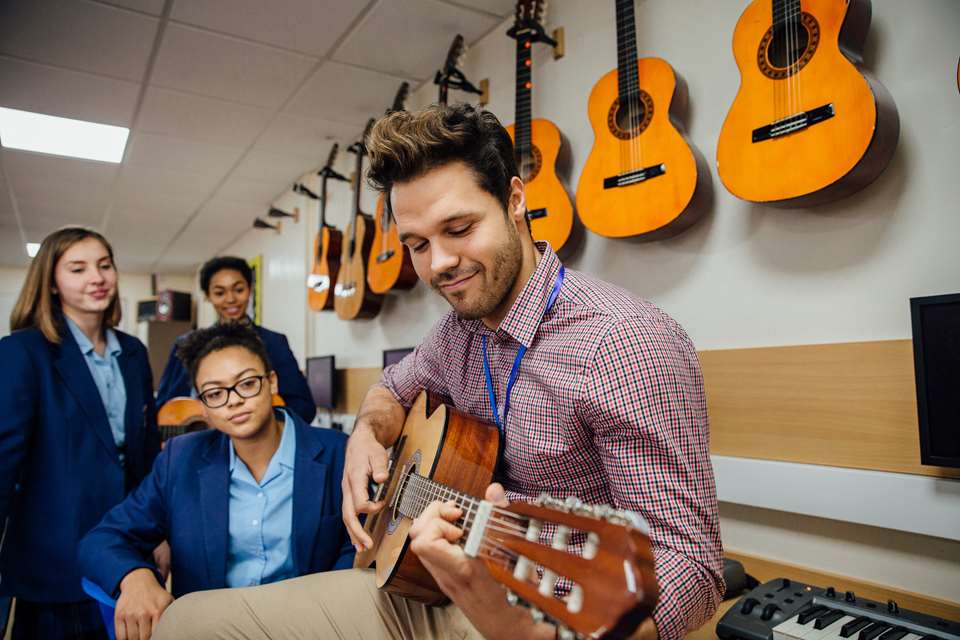The state of music teacher training (November 2023)
Gary Spruce
Wednesday, November 1, 2023
Gary Spruce, visiting lecturer at Birmingham City University, gives an overview of the inconsistency in teacher training.

Adobe Stock / freshidea
[This article was written before the DfE announcement of music bursaries for 2024/25]
Much concern has been expressed recently concerning the consistent under-recruitment of secondary music teachers to initial teacher training courses. On one occasion only (2020/21) during the last 13 years has the DfE target for music teacher recruitment been met, despite this target often being reduced year on year. In 2008/9, 808 trainees registered for secondary music courses. In 2022/23, the figure was 301 against a target of 470. Provisional figures for 2023/24 suggest that position has worsened considerably and only 31% beginner teachers are likely to be recruited against an admittedly much higher target of 790 (DfE, 2023). Nonetheless, this would mean just 233 new secondary music teachers entering the profession in September 2024, 60 fewer than this year.
Since 2021, those registered on music teacher training courses have not been entitled to a bursary to support the payment of fees and to assist with subsistence costs.
Meeting a national need
Over the last five years, there has been a plethora of reports, research reviews, curriculums and plans published relating to music education. Many recognise that it is only in school that all children can access their entitlement to a music education, and consequently it is important that schools have qualified and skilful music teachers as a permanent presence, supporting young people's music education both in and beyond the formal curriculum. One of the goals of the revised (2022) National Plan for Music Education is that ‘All children and young people receive a high-quality music education in the early years and in school’ and that they ‘are supported by a skilled and dynamic workforce’. It is against this backdrop that Simon Toyne, the founder president of the Music Teachers Association, describes the present crisis in secondary music teacher recruitment as ‘the single most important issue that we need to deal with’ (Twitter, May 2023).
Policy and wider context
The challenges to recruiting sufficient music graduates need to be understood in the wider context of government policy around teacher training over the last 13 years. Until 2010, most teachers trained through university-school partnerships led by universities. Since 2010, government policy has moved towards diversifying training routes into teaching, and particularly ‘toward an increasingly school-led ITE system’ (DfE, 2016: 28). This shift from university- to school-led teacher training has been a significant factor in the closure of around half of university music PGCE courses since 2010. A recent ‘market review’ of teacher training (DfE, 2022), ostensibly aimed at rationalising the fragmentation of the teacher training system resulting from government policy, required all providers to seek re-accreditation, with success linked closely to their adherence to the government's new, generic Core Content Framework (CCF) for teacher training (DfE, 2019). This re-accreditation process has resulted in the loss of further music provision and significant geographical areas no longer having any teacher or music teacher training provision (Steadman, 2023).
Impact of under-recruitment and on long-term supply
The immediate, and perhaps obvious, impact of fewer trained music teachers is that vacancies remain unfilled. Anecdotal evidence indicates that consequences of this include music lessons taught by non-specialist staff; reduced curriculum time through timetabling music as part of a ‘carousel’; music not being taught in Year 9; or, in extreme cases, music's removal from the Key Stage 3 curriculum.
A further consequence, posing a greater long-term threat to teacher supply, is that music teacher shortages become embedded into the fabric of music education through further loss of capacity to train teachers. All secondary music teacher training routes depend greatly on experienced and knowledgeable music teachers working alongside and supporting beginner teachers in schools on a day-to-day basis. The long-term impact of the ongoing under-recruitment of music teachers is that the pool of school-based music teachers able to provide such support diminishes. Potential consequences of a lack of teachers able to support student music teachers in schools are providers withdrawing from music teacher training, and university-school partnerships finding it increasingly difficult to find schools able to offer placements for music student teachers. Thus, under-recruitment and music teacher shortages become self-perpetuating.
Alternatively, student teachers are mentored by non-specialist teachers who are unlikely to be able to support their induction into the distinctive pedagogies of secondary music teaching. This leads to increasing genericism in teacher training, fuelling concerns already expressed in relation to the introduction of the CCF and reduction in time for subject specific training (UCL, 2022).
What can be done?
There is no short-term fix for what is a long-term problem. Although solutions must include addressing issues around workload and salary, there is also a need to counter the official undervaluing of music as a subject in schools. The Independent Society of Musicians (ISM) note, for example, how ‘Arts subjects have been devalued in secondary schools by the introduction of the English Baccalaureate (2010) and Progress 8 (2016) accountability measures’. A strong positive vision for music as a profession needs to be articulated which goes beyond the laudable discourses of positivity to encompass the reassertion of professional agency and autonomy. Music teachers in school increasingly reflect the diversity of music-making in wider society. It is important, then, that potential music teachers can recognise themselves as musicians and music teachers in official curricular and policy. It is also important to the idea of music teachers as professionals that there are means by which the diverse range of music teacher voices can be heard and acted upon in the formulation of such policy. Some subject associations are making significant steps towards making this happen. A critical first step, however, must be the reintroduction of the bursary for student music teachers. Many potential recruits to teacher training courses are young music graduates already repaying student loans from their first degree. Having to take on additional debt can act as a significant disincentive to embarking on a teacher training course, particularly for those from economically disadvantaged groups.
I referred earlier to the ‘plethora’ of reports, plans and curriculum documents relating to music education that have been published over the last five years, many of these government initiated. Without qualified teachers in schools able to act on these documents, they will remain just that: documents, with little life or purpose.
References
- DfE (2023) Postgraduate initial teacher training targets.
- DfE (2016) Educational Excellence Everywhere. Crown Copyright.
- DfE (2022) Initial teacher training (ITT) market review.
- DfE (2019) Initial teacher training (ITT): Core Content Framework.
- Steadman, S. (2023) ‘Who is it that can tell me who I am? What the ITE reforms in England mean for teacher identity’. Ellis, V. (ed.) Teacher Education in Crisis. The State, the Market and the Universities in England. Bloomsbury.
- University College London (2022) Expertise in being a generalist is not what student teachers need. Blog.


